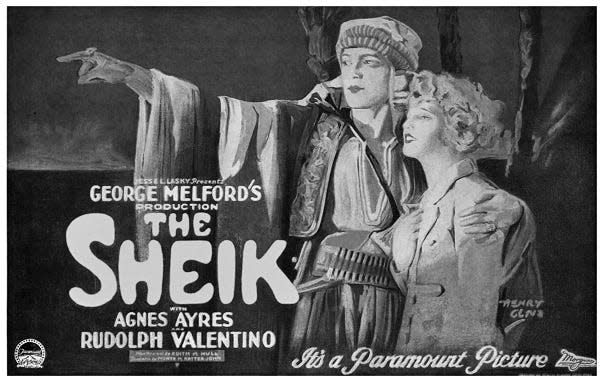Looking Back: Charlevoix in the Roaring Twenties
- Oops!Something went wrong.Please try again later.

One hundred years ago, the Charlevoix Courier of April 12, 1922 reported that the town was about to receive a cultural phenomenon that had begun to sweep the country the previous November, just before Thanksgiving. It was the movie “The Sheik,” starring Rudolph Valentino, the heartthrob of his day, in his second major cinema appearance.
After a silent screen start in inconsequential bit and secondary roles, Valentino was tapped to co-star in the March 1921 “The Four Horsemen of the Apocalypse,” becoming one of the first films to gross $1 million dollars at the box office. And it brought Valentino a lot of attention, enough so that he climbed to second billing below leading lady Agnes Ayers for “The Sheik.” Critical reception was mixed, some critics pouncing on his much too smoldering pretty-boy aura, but audiences worldwide went wild for the ultra pulse-pounding, and totally unbelievable, “ ... love in the Saharan desert.” It was believed to have been partially filmed in the California sand dunes.
“The Sheik” ran in Sydney, Australia for 42 weeks, and one theater in France offered it, and it alone, for eight months. In Charlevoix, the movie was booked for two days, April 22 and 23. The advance publicity said, “Some of the scenic effects are remarkable, and while the situations are thrilling, the love appeal is most compelling.” But perhaps not as compelling as in the novel on which it was based.
The remarkable thing about “The Sheik” is that it actually had to be toned down from the graphic prose of the recent best-seller of the same name written by Edith Maude Hull, which faced the topics of racial miscegenation and sexual matters head-on, quite controversial for its day. Some portions were considered too daring to be filmed. Director George Melford is quoted as saying, “We have handled the frank scenes in ‘The Sheik’ so delicately that I think the censors will be the only disappointed reviewers.” It would be interesting to know how the movie was received in Charlevoix.
That same issue reveals how the Courier had expanded its readership reach to include reportage from all over Charlevoix County and even Antrim County. In one section called “Correspondence,” volunteer reporters reported on the goings and comings, activities, etc. of East Marion (township) — “Lee Pierce has purchased an Overland car” and “Earl Dodd had a telephone installed in their home Monday;” Barnard Township; Phelps School — “The sixth grade completed the study with a test, Monday of last week;” Marion Center School —“We now have an enrollment of twenty-nine;” North Ironton; Bay Shore; Clarion (on Walloon Lake); Atwood, and Ellsworth (several column inches each week); plus items from now unrecognized places like Miles District, Bentley Hill School and Rock Elm. The Courier, a century ago, teemed with local and area news, no matter how seemingly mundane. To many people, it was a thrill to see their names and activities in print.
Again in the April 12 issue, a stunning report on the damage that the two recent back-to-back winter storms, an onslaught the fiercest in living memory, had wreaked on northern Michigan: “It is estimated, closely, that the two storms cost the (Michigan State Telephone) company 13,000 poles and 12,000 circuit miles of wire.” It would be quite a while before full service could be resumed. The MSTC had started to import telephone poles by the trainload, and “thousands of men were sent out into the storm zone. Its linemen braved zero weather and untold hardships.”
This article originally appeared on The Petoskey News-Review: Looking Back: Charlevoix in the Roaring Twenties
